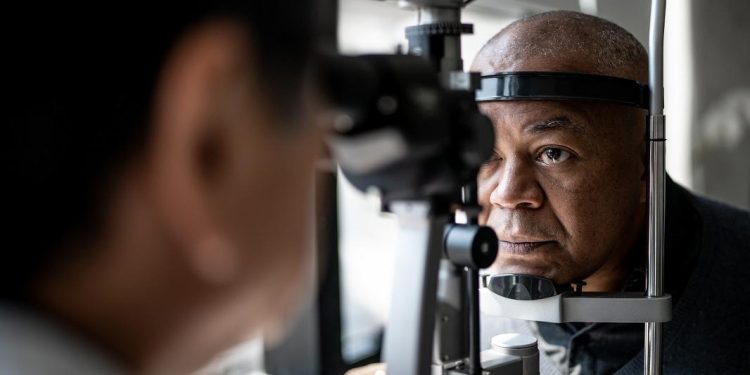HERSHEY, Pa. — Your eyesight is just fine, so why bother with seeing an eye doctor. Right?
As you read this, you can’t feel the pressure of fluids moving inside your eye that make the delicate instrument work. That pressure might be building right now. Too much pressure can cause damage to the optic nerve, which can lead to vision loss or, worse, end in blindness. But if it’s happening, you can’t feel that either. In fact, you may not notice any symptoms until it’s too late.
And it’s not rare. About 3 million Americans suffer from glaucoma, according to the U.S. Centers for Disease Control and Prevention. It’s the second leading cause of blindness in the world, and half of people with the most common form of glaucoma don’t even realize they have it.
Dr. Tara O’Rourke, an optometrist at Penn State Health Eye Center, discusses glaucoma, its causes, its treatment and how early detection can make all the difference.
What causes glaucoma?
A variety of types of glaucoma exist. For example, anything from trauma to diabetes can be an underlying cause that changes the production or outflow of fluid in the eye.
The most common type is known as open angle glaucoma, which occurs when the tiny canals that naturally drain away eye fluid become clogged.
“The exact cause or mechanism of open angle glaucoma is unknown at this time. We can manage the eye pressure, but do not have a cure for the disease,” O’Rourke said. Treatment can control it and save your vision.
Heredity and age are factors. O’Rourke recommends at least yearly testing for anyone over 50 ? even if you have perfect vision. If someone in your immediate family has it, she suggests testing even earlier.
What happens if it goes untreated?
Most of the time, you won’t notice any symptoms in the early stages. Some patients can experience pain, cloudy vision and a sensitivity to light. However, most patients do not experience physical symptoms, but a slow progressive peripheral vision loss, which is irreversible.
Without treatment, the end result is total vision loss.
How do you treat it?
The good news for patients is that glaucoma is treatable, especially in early stages and, if found early, treatment can prevent vision changes. Someone diagnosed with the disease can work with an eye care provider to determine the right plan to control it. That might include a combination of options:
- Eyedrops are the most common treatment. A variety of drops perform different duties. Some drops decrease fluid production. Others help to improve fluid outflow. Some drops come with side effects, which vary depending on type of eyedrop medication prescribed. The most common side effect is redness and burning, however that typically improves with use. One variety includes an ingredient called prostaglandin, which actually is proven to make eyelashes longer and thicker. The eyedrops are not a temporary fix; someone with glaucoma will likely need to continue with drops indefinitely.
- Laser therapy can be used to enhance the outflow of fluid through the drainage system of the eye by opening channels in the meshwork to decrease the pressure. Most people will need to continue taking some sort of medication to keep the pressure in the eye down.
- Oral medications can also lower the pressure.
- Surgical options. These include installing tiny tubes called stents, akin to what a cardiologist uses to unblock an occluded artery in a heart patient. In the eye, smaller versions of the tubes help clear fluid. A doctor may perform this procedure for patients with glaucoma who are also having surgery to remove cataracts.
How do you test for glaucoma?
Generally, doctors test to determine the pressure in a patient’s eye. Normal pressure is anywhere from 10 mmHg (millimeters of mercury) to 21 mmHg. Anything over 21 is typically a reason to pursue further testing.
Many eye doctors perform what’s called a puff test. A machine blows a puff of air into a patient’s eye, and the puff bounces back to the machine, which gauges the pressure.
O’Rourke and her colleagues at Penn State Health Eye Center typically use a device called a topopen or goldman applanation, which is a more accurate way to measure eye pressure. With this test, a drop is first instilled to numb the eye, then the device gently taps or rests on the front surface of the eye to get a better reading.
“Some people say they don’t need glasses, so they don’t need to see an eye doctor,” O’Rourke said. “It’s important for everyone to have yearly eye exams to monitor the health of the eye, especially for patients over the age of 50.”
Glaucoma is just one reason. Patients may have perfect vision but still have underlying issues without symptoms, such as minor retinal tears, that could grow progressively worse.
Glaucoma doesn’t move quickly. However, left untreated, it can progress to significant vision loss. The earlier you receive a diagnosis, the better your chances of protecting your vision.
Related content:
- The Medical Minute: Diabetes diagnosis demands close eye on vision
- The Medical Minute: How parents can prioritize their child’s eye health
The Medical Minute is a weekly health news feature produced by Penn State Health. Articles feature the expertise of faculty, physicians and staff, and are designed to offer timely, relevant health information of interest to a broad audience.




